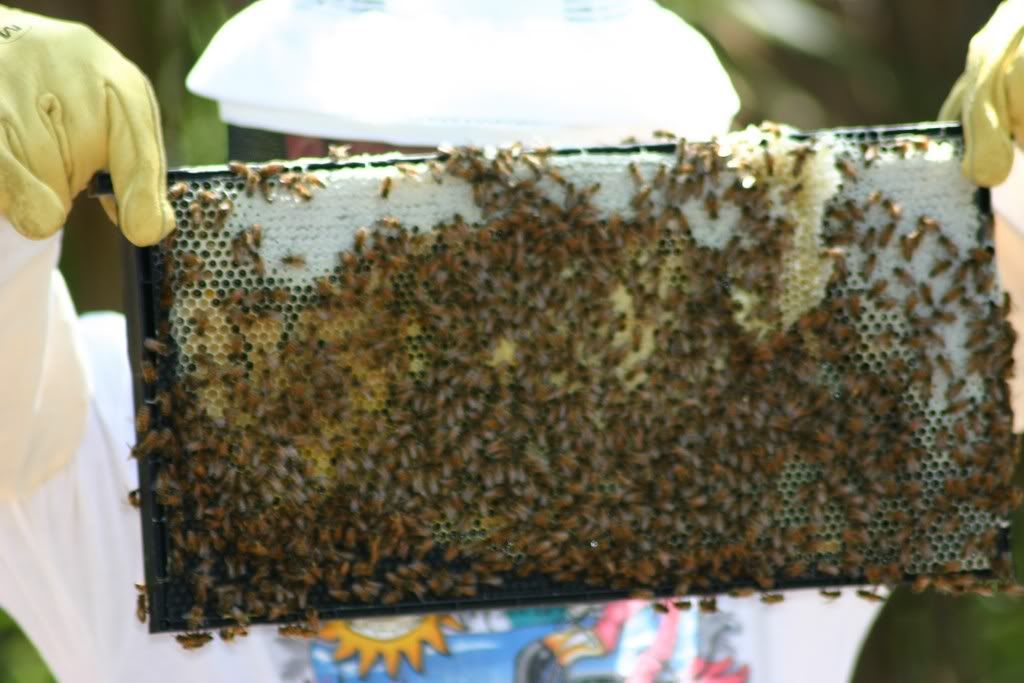
Here are the bees after been sprayed with sugar water. The day I installed my package was a very exciting day. It was late April, my hive had been ready and in position for a few days. I took my package, sprayed them down with Sugar water, pried the cover open, tried to pull the syrup can while holding on to the wire that held the queen cage, and ran into the 1st hurdle. We all know Florida is humid and we all know what happens to wood in humidity, right??? Yep, it swells up - Bloody syrup container wouldn’t come out for anything in the world. After a slight panic I decided to put the box on the ground, put my knee on the box, grab on to the can with both hands and pull. I was smart enough to put the lid near by so I could close the box once the can was out of the way. After some wiggling and pulling, the syrup can slid out, and just a couple of bees were able to sneak out before I was able to replace the lid on the package.
This is the moment I realized that both hands were on the can, and there were none left for the wire holding the queen’s cage. In the words of Homer Simpson - DOH!!!!!!!!!!!!! So now I have a box of mad bees with a caged queen rolling around in there somewhere. I accessed the situation: had the nice beekeepers gloves ON. Solution - open the hive, dump half the package until the queen’s cage is visible, reach in and grab it, and close the box again. I pulled it off beautifully, but now I have a lot of really mad bees flying around. As fast as I could, I placed the queen in her place between the middle frames, dumped the rest of the package, closed the hive, and ran for dear life with a total of 3 bee stings.
Four days later I came to look at the progress. I had some uncertainties. First there was what it looked to me like a LOT of dead bees. I know some die in transport, but I don’t know how many, but there were too many to count. I took the hive off the bottom board and dumped all the dead bees out. Second, the queen was still in her cage. Luckily I looked at the hole, and noticed that one of the staples holding the mesh had gone from the top, right into the hole. The point of the staple was sitting there like a sharp stake at the bottom of a hole; most likely that’s why she hadn’t been released. I pulled the screen up and she ran down the frames. From then on, the bees did what bees do and they looked great. These are a couple of the best pictures I took while inspecting it.
These are a couple of the best pictures I took while inspecting it.
Make note of my gloved finger on the top left of the picture. The queen was no more than maybe 6 inches from my finger. I took the picture, looked at the frame, but never saw her until later while looking at the picture. Things looked great.
The funcky comb on the upper right is the original place where I placed the queen cage. The next one is probably a forager transfering nectar.
The fall came in July. We were on vacation, so I’m not sure what happened. What I know is that before I left, the colony had drawn out 5 full frames and it was thriving, so the Small hive Beetles were also beginning to thrive. The day before we left, I decided to install the SHB trap in the sandwich container, and to remove my entrance reducers.
Two weeks later when we returned from vacation, I came back to an empty hive. All that was left were the frames full of Beetles, the maggot looking larva worms, and about 20 young bees that were flying around wondering where the heck every one had gone. Not a drop of honey left. All the honey and pollen cells had been nicely uncapped and cleaned dry. I don’t think anyone but the bees would have done that.
As I took my set up down to clean the mess, I found a Red carpenter ant colony between the landscape timbers and the wheels. I ‘m assuming with all the rain, the ants moved up, started harassing the colony; the colony got fed up and moved away. I can’t be sure, but that’s just my best guess from the evidence.
Quick Links to Local Pollen Count,My TBH, and my Garden
Friday, August 24, 2007
Rise and Fall of Original Set up
Posted by Bee Anonymous: at 7:57 PM
Subscribe to:
Post Comments (Atom)


No comments:
Post a Comment